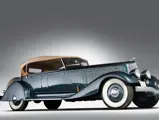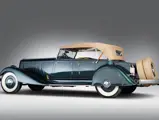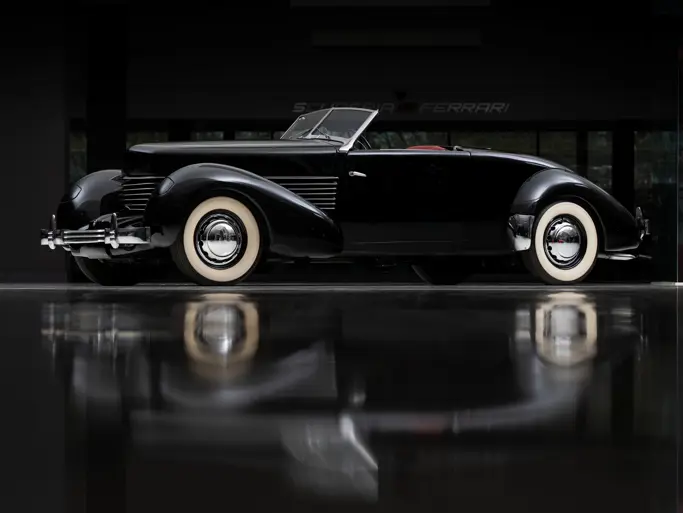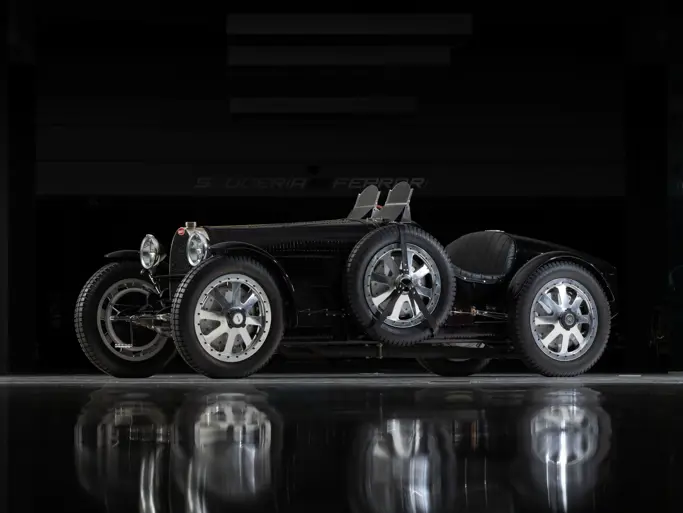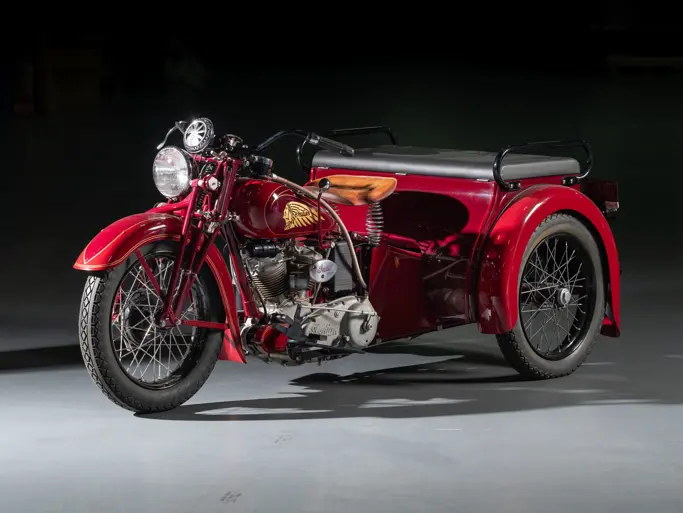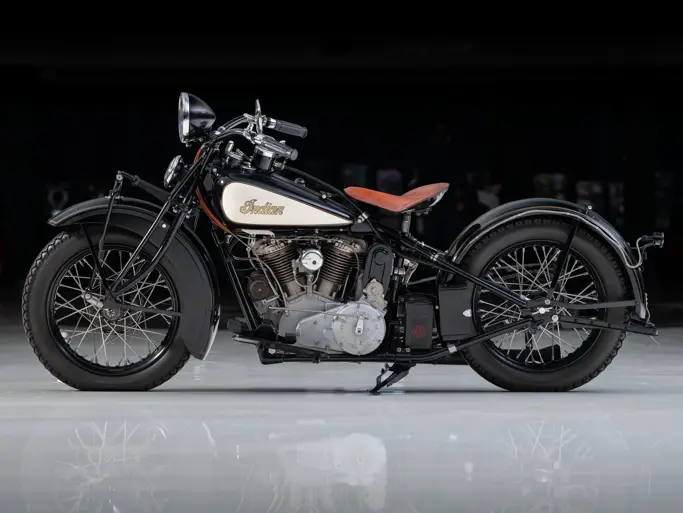The Milhous Collection
1933 Chrysler Custom Imperial Five-Passenger Phaeton
{{lr.item.text}}
$1,210,000 USD | Sold
 | Boca Raton, Florida
| Boca Raton, Florida
{{internetCurrentBid}}
{{internetTimeLeft}}

Series CL. 135 bhp, 384.8 cu. in. eight-cylinder L-head engine, four-speed manual transmission, solid front axle and live rear axle with semi-elliptic leaf springs, and four-wheel hydraulic drum brakes. Wheelbase: 146"
• Stunning personal car of renowned automotive designer Ralph Roberts
• Unique custom features
• Believed to be the last example completed
• Exceptional quality restoration
• Known provenance from new, including Otis Chandler Collection
In July 1930, Chrysler introduced the Series CG Imperial. A vastly different automobile from its predecessor, it was larger, riding a 145-inch wheelbase, and had been completely transformed to what we now recognize as a classic icon. In place of the old 309-cubic inch six was an all-new straight eight, the configuration now favored in the industry. Actually, there were no fewer than four different Chrysler eights, but the Imperial got only the largest, a 384.8 cid, nine-main unit making 125 bhp. The Imperial line had been expanded too and now included four production bodies by Briggs, four catalogued customs and of course individual customs that one could order from a bespoke coachbuilder. The semi-custom bodies, roadster, coupe, convertible coupe and dual-cowl phaeton, were all furnished by LeBaron.
LeBaron and Ralph Roberts
LeBaron Carrossiers, Inc. was formed in New York City in 1920 by Raymond Dietrich and Thomas Hibbard. Their first customer was the New York branch manager for Packard, who commissioned them to draw up a seven-passenger limousine. Fleetwood built the body, and the customer was so satisfied that referrals began to come in. The New York agency for Lincoln ordered a short run of three body styles, a roadster, a berline and a dual-cowl phaeton. LeBaron was off and running.
Dietrich and Hibbard took in Ralph Roberts, a recent Dartmouth graduate, as a partner. Soon LeBaron was supplying bodies for chassis supplied by New York dealers for Rolls-Royce, Mercedes-Benz, Minerva, Fiat, Hispano-Suiza, Packard, Cadillac and Pierce-Arrow, among others. Hibbard left for Europe in 1923, where he associated with Howard “Dutch” Darrin in Hibbard & Darrin.
Late in 1923, the owners of the Bridgeport Body Company in Bridgeport, Connecticut proposed to the remaining LeBaron partners that they become design partners, in exchange for stock. This had the win-win effect of providing Bridgeport Body with designers on tap and giving LeBaron a less-independent crew of constructors.
In 1923, Dietrich had met Edsel Ford at the New York Auto Show. The two hit it off, and a big order from Lincoln resulted. Before long, Lincoln became LeBaron’s best customer. Edsel was so pleased that he tried to get Dietrich and Roberts to move to Detroit. Both men were invited to the Motor City, ostensibly for technical discussions, but the agenda really concerned a buyout. Dietrich went alone because Roberts was ill and, overwhelmed by a generous offer, sold out his share of LeBaron and moved to Michigan.
Roberts and Stickney then soldiered on productively at Bridgeport. In 1927, however, Walter Briggs of Briggs Body Company in Detroit approached Roberts with a buyout offer. Finding it too good to pass up, Roberts accepted and departed for Detroit, where he and LeBaron became an in-house design studio for Briggs. Briggs was a major body supplier to the new Chrysler Corporation, so the supply of LeBaron designs for upscale series was natural. When Chrysler bought out Briggs in 1953, the LeBaron name was part of the package. Chrysler has been using the label on certain prestige models ever since.
Roberts and His One-off Imperial
In early 1932, the Series CG Imperial was succeeded by a new Series CH line, with double-drop frame, Floating Power and vee-type windshield. A long-wheelbase companion model, the CL Custom Imperial, was introduced at the same time. The CL line comprised six catalogued body styles, three of which were by LeBaron, and a handful of individual customs produced for specific customers. Unique to the CL was a longer hood, extending from the radiator shell back to the base of the windshield. Inspired by a car he saw in Paris in 1931, Roberts had a Lincoln so modified. Edsel Ford did not like the Lincoln’s experimental hood, but Walter Chrysler did and ordered it adopted for the new CL.
The CL was carried forward into 1933, with few changes. In 1932 the original dual cowl phaeton was replaced by what many call a sport phaeton with a crank-up rear screen, housed in the back of the front seat.
This Imperial Custom five-passenger phaeton is believed to be the last one completed. It is known to have been the personal car of Ralph Roberts, equipped to his order as a gift for his wife. As Roberts told writer Dennis Adler in 1985, “There were a number of unusual or experimental ideas tried on this car. One was the extended fender line and fender skirts on the rear. The radiator was painted, instead of chromed, the headlights were also different from those on the standard CL series bodies, and instead of having the spare wheels in the fender well, I had them moved to the back of the car.” This was reportedly accomplished with the mounting bracket from an old Locomobile. The wire wheels were also covered with “French discs,” making them look like disc wheels. With regard to the aforementioned headlights, they were placed much lower than usual, presumably an effort by Roberts to lower the frontal view somewhat.
Mrs. Roberts kept the car until the early days of World War II. The Roberts moved from Detroit to California in 1942. He told Adler, “it was hard to get tires and we didn’t want to drive the car across country, so we sold it in Detroit.” Later that year it was purchased by Bob Harrison of San Francisco, still in its original paint and with all the unique features. He kept it until 1960 but made some changes during his stewardship, including black paint and a stone guard. Fellow San Franciscan Bob Burkholder bought the car from Harrison and removed the top, using a canvas tonneau cover instead. The fender skirts became lost along the way, as did the wheel discs. By the time Adler’s article was published in Car Collector magazine in March 1986, the car still had its original upholstery, and the odometer showed some 75,000 miles. It was then in the hands of its seventh owner, Otis Chandler. Later owners would include Chrysler expert Joe Morgan in the early 1990s as well as Neil Wynn, who commissioned a complete restoration by Curt Austin, after which the car was awarded the Most Elegant Open award at Pebble Beach in the mid 1990s.
Prior to its acquisition by the Milhous Collection in 1998, the car resided in another prominent, award-winning collection. The Imperial continues to present fantastically in its correct original Moon Glow Polychromatic (a lovely shade of blue metallic that was introduced at the end of the production year), and great care has been taken to restore the original Roberts-ordered features: wheel discs and fender skirts. The restoration is exquisite throughout. The body contours, paint and trim are all exceptional. The interior is upholstered in tan leather and furnished with a rear seat arm rest. The floors have grey carpet, and the top is tan canvas, with matching tire cover at the rear. A set of side curtains resides in the trunk. The damascened instrument panel is superbly detailed, the odometer currently showing fewer than 78,000 miles, and the rear windshield raises and lowers with ease.
The engine compartment is correctly detailed, showing the red cylinder head with black hammerite block. The chassis and underbody are painted in body-color green, all well detailed. The motif is completed with B.F. Goodrich Silvertown whitewalls, nicely complemented with the reinstalled wheel discs.
Certainly one of the most stunning Chrysler Imperials ever built, this car’s presence is overwhelming. Perhaps Ralph Roberts summed it up best: “We built some really nice cars back then…to use a trite expression, ‘the right guys for the right job at the right time’.” Roberts and his colleagues were the right guys then, and the car holds up to their exceptional standards to this day.

